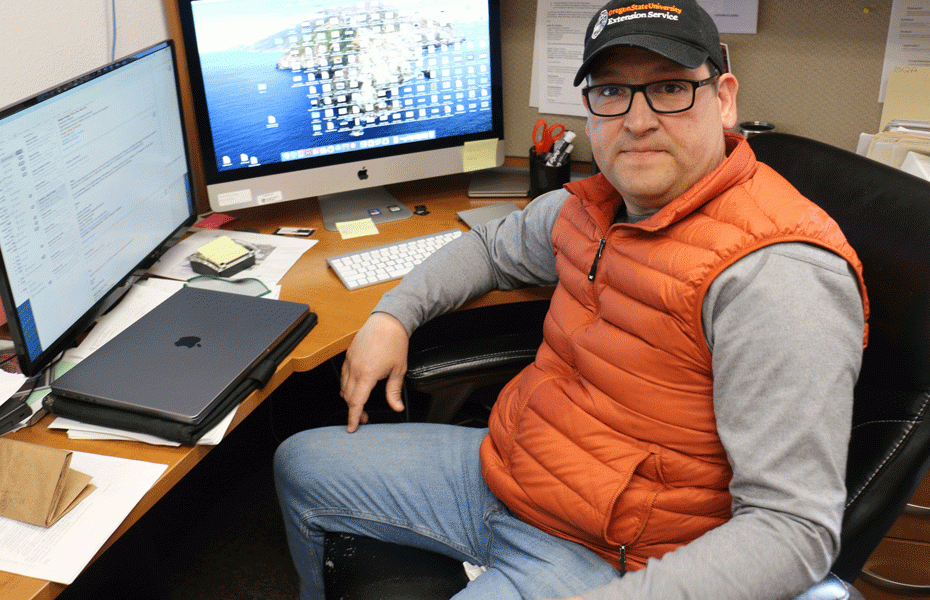ONTARIO – Wildfire stalks Sergio Arispe.
The Oregon State University extension agent understands the influence wildfire can wield on rangeland.
When he allows his mind to wander and it settles on wildfire, the images hover of once pristine rangeland turned to ash.
“Wildfire is bad because it can devastate ecosystems and watersheds. It can negatively affect wildlife and agriculture-based businesses,” he said.
That’s why the local extension agent has spent a lot of time over the past few years working to gather information – and develop a plan to mitigate – fuel loads on the rangelands that make up Malheur County.
As spring slowly creeps into the county, Arispe is already ramping up plans to gather more information on fuel loads.
The objective of the data collection, he said, is to create a baseline for local land managers, cattlemen and the public.
“We want to provide science-based information to keep these fuels down,” said Arispe.
A severe wildfire can turn a section of range into a wasteland, he said.
“Everything is reduced to ash. That includes the plants, the microbes and all the animals that were on that landscape,” he said.
Working through partner agencies such as the U.S. Bureau of Land Management Arispe is busy creating a comprehensive fuels database.
“The data we collect will go toward tools that will help land managers make decisions,” he said.
The tools could go toward a resource such as the Oregon Explorer website. The Oregon State University site is a cornucopia of information about animals and plants, climate, agriculture and land use planning for the state.
“Users can have more precise information about plant communities to mitigate fires and to also understand more about how much fuels are out there on the landscape,” said Arispe.
The fuel reduction effort is just one of the projects Arispe participates in as extension agent.
He serves as a teacher, an advocate and scientist in an effort to be a resource for cattle producers, the public, agriculturists and state and federal agencies.
Arispe stepped into the extension agent slot in Ontario in 2014.
“It is the best job. It integrates animal science with public education and rangeland science. Those pillars really make the position here for OSU,” said Arispe.
Arispe said another advantage to the position is it does not tie him down to a classroom.
“I’m able to work with livestock producers, land managers and the public. It also contains work with cattle, at the cow-calf level and the feedlot level,” said Arispe.
Arispe’s road to Malheur County began when he decided to participate in a Future Farmers of America class when he was a teenager in his hometown of Houston, Texas.
It didn’t take long for the program’s agriculture emphasis to grab his attention.
“When I joined FFA I started to judge livestock. When I would then go out and train outside of the city I just really enjoyed the solitude and the silence of the open fields,” said Arispe.
His eventually served a stint in the Peace Corps in South America to stops at various colleges, including earning a doctorate in animal biology from the University of California-Davis in 2012.
Arispe, 44, said local agriculture faces several challenges.
“The greatest is sustained, long-term efforts to fund education programs that provide healthy landscapes,” said Arispe.
The health of natural resources is crucial, said Arispe.
“If our natural resources are not there, in particular Malheur County but in our region, we will lose out on any type of recreation, like hunting, fishing, camping, hiking. We will also lose our rangeland-based businesses like ranching,” said Arispe.
For Arispe, the focus then must be on landscapes where wildlife, cattle and humans co-exist and prosper.
Arispe said links with state and federal agencies, along with nonprofits and agriculture producers for a common goal.
“We’ve worked on critical topics such as programs to improve sage grouse habitat to keep the greater sage grouse out of a fish and wildlife listing. I’ve also worked with local nonprofits and agencies to equip land managers with tools to create land management plans,” said Arispe.
Education is also a big part of his job, said Arispe.
“What I do is work to identify needs facing stakeholders. Once those needs are identified I create curriculum, develop programming with partners – cattle producing partners and natural resource management partners,” said Arispe.
A good example, said Arispe, was a recent program regarding low-stress cattle handling.
“It was identified by cattle producers in 2018. They were interested with low stress cattle handling on the ranch as well as at auction and the feedlot,” said Arispe.
Arispe was then able to set up seminars and workshops in places like Vale and Jordan Valley for cattle producers with an expert on the low-stress cattle-handling procedures.
Arispe said low-stress cattle handling is “socially responsible.”
“The intent is to reduce physical harm to either the animal or the handlers,” said Arispe.
Low-stress cattle handling also pays off in terms of the quality of beef, said Arispe.
“Without a lot of whipping or prodding you can get them (cattle) through facilities in a calmer way and it can be especially profitable because of less bruising and less injury to the animal,” said Arispe.
Arispe said he believes the program to reducing fuel loads on rangeland is one of the most significant of his career. The program, he said, is a cooperative effort between cattle producers, the Vale District of the Bureau of Land Management and other state and federal agencies.
“We are working as a partnership to improve degraded rangeland. As a partnership we’ve secured almost $700,000 in grants in the last five years to research grazing in the dormant season and how we can improve degraded rangeland,” said Arispe.
The ability to make an impact motivates Arispe.
“The fact that we can have, after a low-stress cattle handling field day, cattle producers that can go back and be safer and implement safer practices to safeguard their health or their animals health has meaning,” said Arispe.
News tip? Contact reporter Pat Caldwell at [email protected].
HOW TO SUBSCRIBE – The Malheur Enterprise delivers quality local journalism – fair and accurate. You can read it any hour, any day with a digital subscription. Read it on your phone, your Tablet, your home computer. Click subscribe – $7.50 a month.




